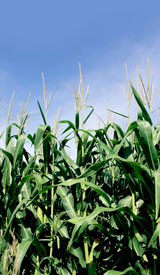May 10, 2008
Contact: Dr. Don Viands, Cornell University, 6087-255-3081,
NNYADP Co-Chairs Jon Greenwood, 315-386-3231, Joe Giroux, 518-563-7523
Grass for Energy Research Expanded in NNY
Cornell University Plant Breeder Dr. Donald R. Viands says Northern New
York (NNY) farmland is well-suited to produce grasses and legumes as
bioenergy crops. Viands and a team of researchers from Cornell
University and Cornell Cooperative Extension are evaluating a crop trial
started in 2007 in western NNY and will plant new a warm and cool season
grass trial at the William H. Miner Agricultural Research Institute in
Chazy in eastern NNY in May 2008.
Viands says grasses and legumes have the potential to be more economical
and environmentally sustainable for making biofuel than corn-for ethanol
production.
�Corn is an annual crop that requires substantial inputs each planting
year, whereas grasses and legumes are perennials that can be harvested
for several years with very little input,� Viands says. �The cellulosic
conversion process used to produce ethanol from grasses and legumes
utilizes a greater percentage of the plant than the corn-ethanol
conversion process, and perennial grasses reduce greenhouse gas
emissions by sequestration of carbon from the atmosphere and reduce soil
erosion through production of an extensive root system.�
In 2007, with funding from the Northern New York Agricultural
Development Program, the Cornell research team planted warm season
perennial grasses (switchgrass, big bluestem, indiangrass, Eastern
gamagrass and coastal panic grass) at Belleville-Henderson Central
School in Belleville, NY, to evaluate the different grasses for use as a
bioenergy feedstock.
Viands says a grass stand of approximately 40 percent in the
establishment year at the school is a good indication of a successful
planting. Some varieties established themselves better than others - a
full report of the 2007 results is online at
www.nnyagdev.org.
The trial at Miner Institute will be similar to the trial at Belleville.
Evaluation of the performance of the grasses in the different locations
will help to identify which species and varieties will generate the
maximum biomass production in Northern NY. The research at Miner
Institute also includes cool season grasses (domestic tall wheatgrass,
reed canarygrass, tall fescue, and smooth bromegrass).
Viands says, �Large quantities of biomass will be needed to supply the
cellulosic pilot ethanol conversion plants that are planned to be built
in New York and are expected to be in operation in 12-18 months, but
there is a lack of data on the growth and development of different
species of warm season grasses in Northern New York. Cool season grasses
are well adapted to the North Country, but may not yield as much as warm
season grasses in a low input management system.�
Energy (BTUs) and ethanol produced per acre from the various grasses
planted in the New York trials will be assessed along with seedling
vigor, ease of crop establishment and susceptibility for weed
encroachment, disease and insect damage.
The Northern New York trials will be compared with results from New York
Farm Viability Institute funded trials in other regions of New York
State.
Cornell University is one of five land-grant universities in the U.S.
selected as a regional Sun Grant Initiative Center. The Sun Grant
Initiative is a national program committed to strengthening rural
economies and communities through support of biomass-based industries
and agricultural sustainability.
For more information on biofuel production in Northern New York, go
online to www.nnyagdev.org. The
Northern New York Agricultural Development Program is a farmer-driven
research, outreach and education program for Clinton, Essex, Franklin,
Jefferson, Lewis and St. Lawrence counties. # # #



